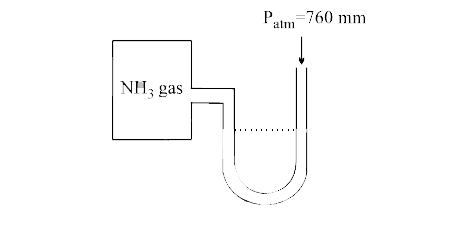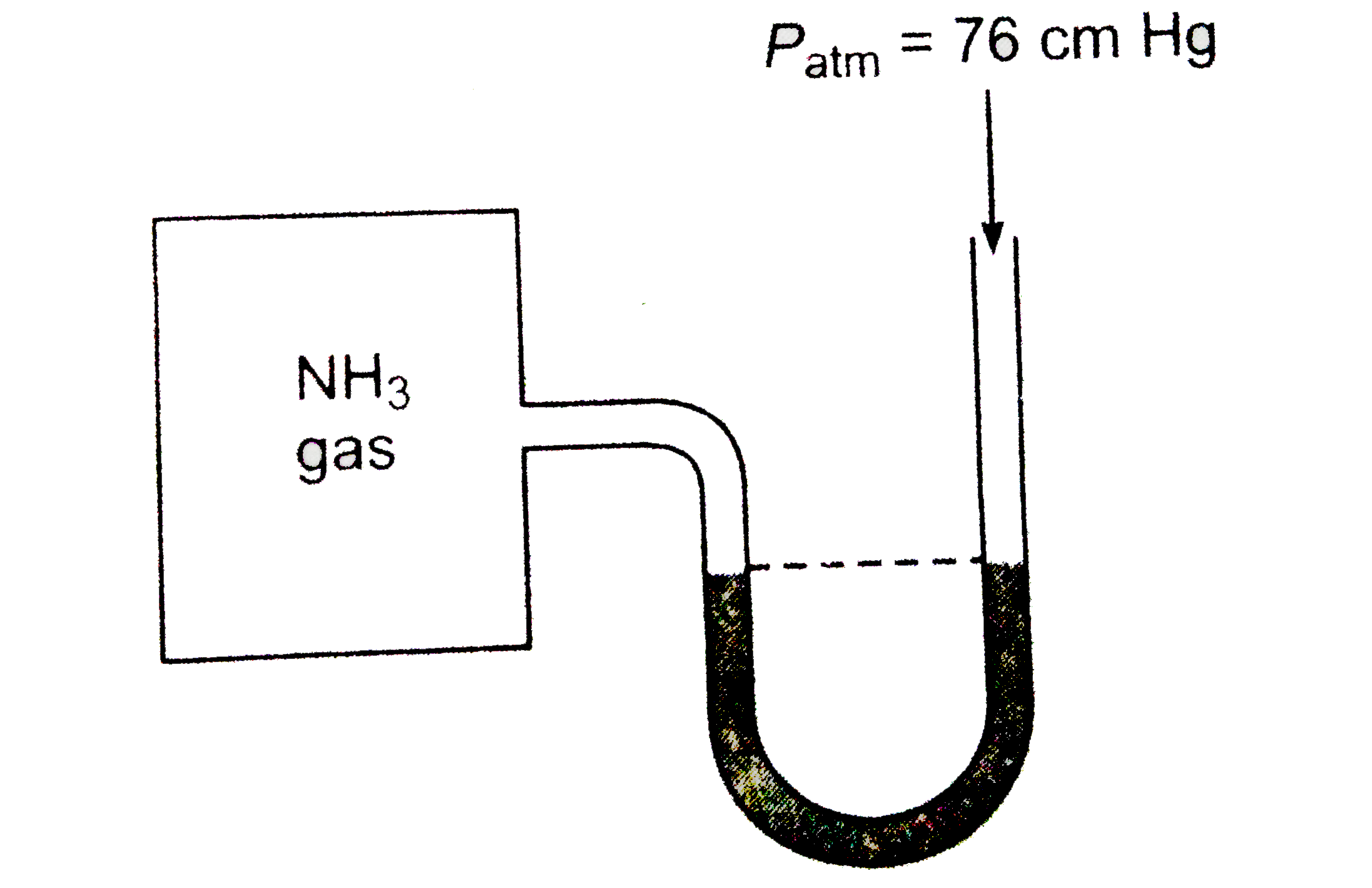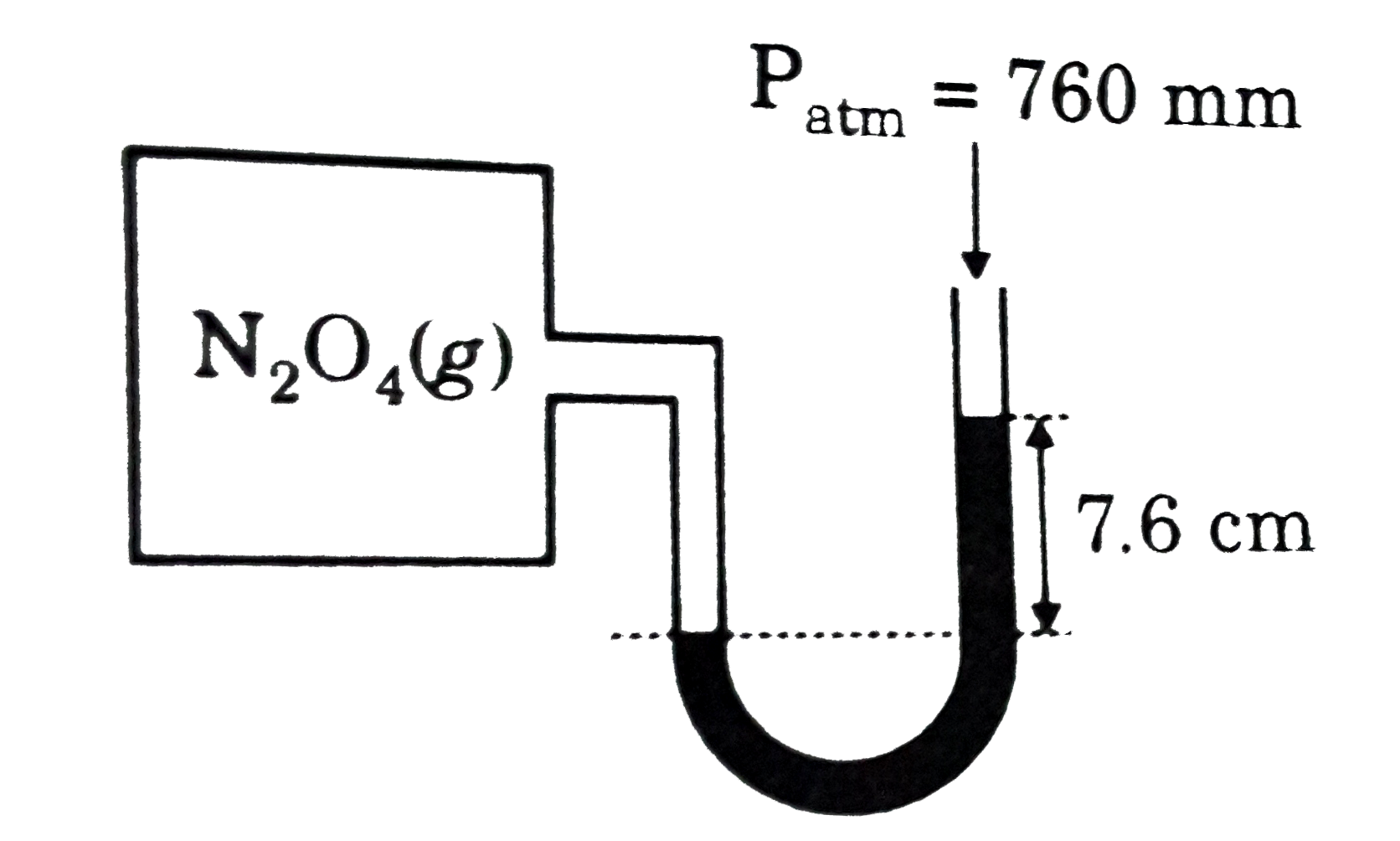A manometer attached to a flask contains NH3 gas have no difference in mercury level initially as shown in diagram.After the sparking into the flask, it have difference of19 cm in mercury level in two columns.Calculate % dissciation of ammonia

The correct Answer is:0.25
Topper's Solved these Questions
- GASEOUS STATE BOOK - MOTIONCHAPTER - GASEOUS STATE EXERCISE - EXERCISE-4( LEVEL-I)
15 Videos
- GASEOUS STATE BOOK - MOTIONCHAPTER - GASEOUS STATE EXERCISE - EXERCISE-4( LEVEL-II)
19 Videos
- GASEOUS STATE BOOK - MOTIONCHAPTER - GASEOUS STATE EXERCISE - EXERCISE-2(LEVEL-II)
35 Videos
- ELECTROCHEMISTRYBOOK - MOTIONCHAPTER - ELECTROCHEMISTRYEXERCISE - EXERCISE-4,II
44 Videos
- GOCBOOK - MOTIONCHAPTER - GOCEXERCISE - Exercise - 4 Level - II
14 Videos
Similar Questions
A manometer attached to a flask contains with ammonia gas have no difference in mercury level initially as shown in diagram. After sparking into the flask, ammonia is partially dissociated as 2NH3 (g)→N2 (g)+3H2 (g) now it have difference of 6 cm in mercury level in two columns, what is partial pressure of H2 (g) at equilibrium?

View SolutionA open ended mercury manometer is used to measure the pressure exerted by a trapped gas as shown in the figure. Initially manometer shows no difference in mercury level in both columns as shown in diagram.

After sparking 'A' dissociates according to following reaction
A(g)→B(g)+3C(g)
If pressure of Gas "A" dissociates to 0.9 atm, then (Assume temperature to be constant and is 300 K)
View Solution
Knowledge Check
A manometer attached to a flask contains with ammonia gas have no difference in mercury level initially as shown in diagram. After sparking into the flask, ammonia is partially dissociated as 2NH3 (g)→N2 (g)+3H2 (g) now it have difference of 6 cm in mercury level in two columns, what is partial pressure of H2 (g) at equilibrium?
 A9 cm HgB18 cm HgC27 cm HgDNone of these
A9 cm HgB18 cm HgC27 cm HgDNone of theseA open ended mercury manometer is used to measure the pressure exerted by a trapped gas as shown in the figure. Initially manometer shows no difference in mercury level in both columns as shown in diagram.

After sparking 'A' dissociates according to following reaction
A(g)→B(g)+3C(g)
If pressure of Gas "A" dissociates to 0.9 atm, then (Assume temperature to be constant and is 300 K)Atotal pressure increases to 1.3 atmBtotal pressure increases by 0.3 atmCtotal pressure increases by 22.3 cm of HgDdifference in mercurry level is 228 mm.An open ended mercury mnometer is used to measure the pressure exerted by a trapped gas as shown in the figure. Initially manometer shows no difference in mercury level in both columns as shown in diagram.

After sparking A dissociates according to following reaction:
2A(g)→3B(g)+2C(g) ltbr> If pressure of Gas A decreases to 0.8 atm. Then:
(Assume temperature to be constant at 300K)Atotal pressure increased by 1.3 atmBtotal pressure increased by 0.3 atmCtotal pressure increased by 22.3 cm of HgDdifference in mercuty level is 228mm
In a container initially only N2O4 is present and no difference in height of Hg-column of two limbs :

If due to dissociation of N2O4 at constant temperature the difference in the column of mercury becomes 7.6 cm then calculate % dissociation of N2O4.[N2O4→2NO2]
View SolutionIn a constant volume gas thermometer, the pressure of the working gas is measured by the difference in the levels of mercury in the two arms of a U-tube connected to the gas at one end. When the bulb is placed at the room temperature 27.00C, the mercury column in the arm open to atmosphere stands 5.00cm above the level of mercury in the other arm. When the bulb is placed in a hot liquid, the difference of mercury levels becomes 45.0cm. Calculate the temperature of the liquid. (Atmospheric pressure =75.0cm of mercury).
View SolutionIn a constant volume gas thermometer, the pressure of the working gas is measured by the differenced in the levels of mercury in the two arms of a U-tube connected to the gas at one end. When the bulb is placed at the room temperature 27.00C, the mercury column in the arm open to atmosphere stands 5.00cm above the level of mercury in the other arm. When the bulb is placed in a hot liquid, the difference of mercury levels becomes 45..0Cm. Calculate the temperature of the liquid. (Atmospheric pressure =75.0cm of mercury).
View SolutionArrange the following steps in proper sequence to determine the pressure exerted by a gas enclosed in a container using a manometer.
(a)Connect one end of the manometer to the container filled with gas.
(b)Both the limbs of the manometer are exposed to air, mercury level in both the limbs are equal due to atmospheric pressure.
(c )Determine the difference in level of the mercury in both the limbs of the manometer (l).
(d) If the level of the mercury in the limb connected to the container is above the mercury level in the limb exposed to air, the pressure of the gas in the container is determined as atmospheric pressure -l.
(e ) If the level of the mercury in the limb connected to the container is below the mercury level in the limb exposed to air, the pressure of the gas in the container is determined as atmospheric pressure +l.
(f) Note the level of the mercury in the limbs of the manometer.
View SolutionArrange the following steps in proper sequence to determine the pressure exerted by a gas enclosed in a container using a manometer.
(A) Connect one end of the manometer to the container filled with gas.
(B) Both the limbs of the manometer are exposed to air, mercury level in both the limbs are equal due to atmospheric pressure
(C) Determine the difference in level of the mercury in both the limbs of the manometer (t).
(D) If the level of the mercury in the limb connected to the container is above the mercury level in the limb exposed to air, the pressure of the gas in the container is determined as atmospheric pressure - l
(E) If the level of the mercury in the limb connected to the container is above the mercury level in the limb exposed to air, the pressure of the gas in the container is determined as atmospheric pressure +l
(F) Note the level of the mercury in the limbs of the monometer.
View Solution
